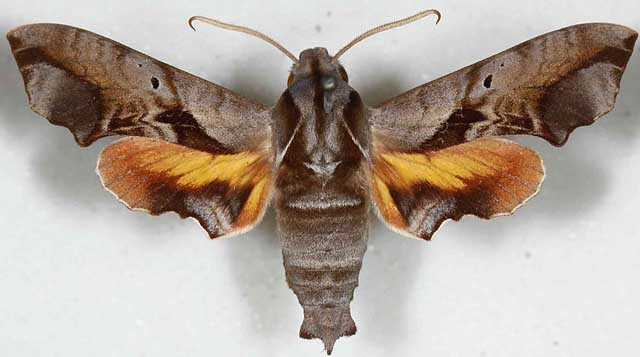Nyceryx brevis
Nyceryx brevis
Becker, 2001

Nyceryx brevis, approx. 45mm, Serra do Cipo, Minas Gerais, Brazil, courtesy/copyright of Jean Haxaire;
CC BY 3.0, https://commons.wikimedia.org/w/index.php?curid=62625606.
This site has been created by Bill Oehlke.
Comments, suggestions and/or additional information are welcomed by Bill.
TAXONOMY:
Family: Sphingidae, Latreille, 1802
Subfamily: Macroglossinae, Harris, 1839
Tribe: Dilophonotini, Burmeister, 1878
Genus: Nyceryx Boisduval, [1875] ...........
Species: janzeni Haxaire, 2005
|
DISTRIBUTION:
Nyceryx brevis
(approximate wingspan: mm // fwl: 20-22mm) flies in cerrado habitat in
Brazil: HT Bahia: Morro do Chapeu, 1400 m, 23-24.IV.1991; Minas Gerais, Serra do Cipo and Belo Horizonte, [Retiro das Pedras], 1300 m.
This species if similar to continua continua but N. brevis is much smaller, and perhaps that is why it was named brevis.
I suspect it also flies in cerrado biome in Pernambuco, Piaui and Tocantins, but have no confirmed reports for those states. Haxaire & Mielke, 2019, suggest it
may be limited to Minas Gerais and Bahia.
FLIGHT TIMES:
Moths are probably on the wing in just about every month with confirmed reports for January and April. However, in drier habitatit may be
limited to rainier season.
ECLOSION:
Adults eclose, usually within three to five weeks from pupation date.
SCENTING AND MATING:
Females call in the males with a pheromone released from a gland at the tip of the abdomen.
Females are active just after midnight with males beginning night flight around 1:00 am.
EGGS, LARVAE, PUPAE:
Larvae possibly feed on Pentagonia donnell-smithii, and Chimarrhis parviflora, but neither food plant has been
confirmed. Inga species should also be explored.
Isuspect the species name, fernandezi, is honourific for Fernandez.
Return to Sphingidae Index
Return to Dilophonotini Tribe
Goto South American Index

